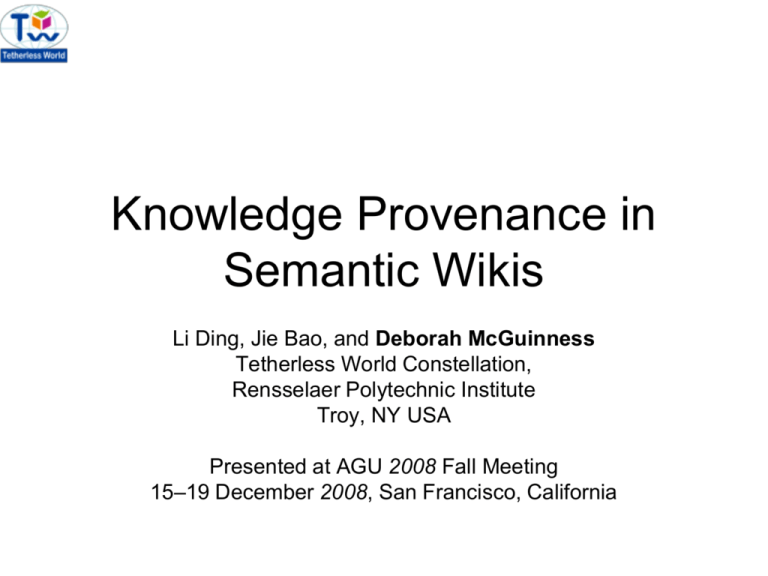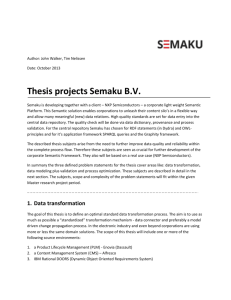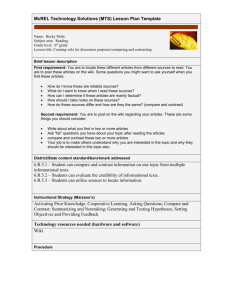- Tetherless World Constellation
advertisement

Knowledge Provenance in Semantic Wikis Li Ding, Jie Bao, and Deborah McGuinness Tetherless World Constellation, Rensselaer Polytechnic Institute Troy, NY USA Presented at AGU 2008 Fall Meeting 15–19 December 2008, San Francisco, California Emerging Web Semantics Web 1.0 Collaborative Authoring • Web 1.0: online text • Web 2.0: collaborative online text • Web 3.0: collaborative online knowledge Web 3.0 Web 2.0 Structure and Semantics Preservation Motivation Question What has been done to my homepage? • Existing approaches – Internet Archive: “when” – Wiki history: “when”, “who” • In Semantic Wiki – Represent changes – Query changes Semantic History • Automatically convert Wiki History to Knowledge Provenance interlingua – PML (Proof Markup Language). This links semantic web data to information about where it came from. • We provided triple level granularity for knowledge provenance in Semantic Media Wiki • We support semantic queries over knowledge provenance as well as content Encoding Wiki History Using PML hasConclusion Version 2 of Page A NodeSet A2 User:Joe hasInferenceEngine isConsequentOf hasInferenceRule InferenceStep X ex:Revision hasAntecedent hasCreationDatatime 17:17, October 22, 2008 hasConclusion Version 1 of Page A NodeSet A1 Knowledge Provenance Interlingua • PML1 was introduced in 2002 – It has been used in multiple contexts ranging from explaining theorem provers to text analytics to machine learning. – It was specified as a single ontology • PML2 improves PML1 by – Adopting a modular design: splitting the original ontology into three pieces: provenance, justification, and trust • This improves reusability, particularly for applications that only need certain explanation aspects, such as provenance or trust. – Enhancing explanation vocabulary and structure • Adding new concepts, e.g. information • Refining explanation structure 6 PML Provenance Ontology • Scope: annotating provenance metadata • Highlights – Information – Source Hierarchy – Source Usage 7 Initial Results •(cur) (last) 17:17, October 22, 2008 Li (Talk | contribs | block) (420 bytes) (rollback | undo) •(cur) (last) 20:42, August 24, 2008 Baojie (Talk | contribs | block) (345 bytes) (undo) •(cur) (last) 23:44, August 15, 2008 Baojie (Talk | contribs | block) (331 bytes) (undo) Ongoing Work SMW History and Temporal RDF Wiki Page “DLM” Wiki Page “Triple 1” Wiki Page “interval t1” 2008-11-12 begin-datetime tw:DLM rdf:subject interval Interval t1 end-datetime foaf:firstName rdf:predicate Triple 1 2008-11-14 interval rdf:object Deborah • Referring RDF triple via Reification • integrating temporal data within RDF Claudio Gutiérrez, Carlos A. Hurtado, Alejandro A. Vaisman - Temporal RDF. In ESWC pp. 93-107, 2005 Ongoing Work Semantic History Computation PO1 PO2 PO3 (triple, r_add, r_del) R1 X (po1,r1,null) R2 X (po1,r1,t2) (po2,r2, null) R3 X X (po1,r3,null) R4 X R5 X R6 X X (po1,r3,t4) (po3,r4,null) X (po1,r5,null) (po2.r2,r5) Change of an RDF wiki page POi:Property and object, Ri: for revision id. Space complexity DELTA O(m)<= DELTA <=O(m*n) m: # of triples n: # of revisions (po1,r5,r6) (po2,r6,null )(po3,r4,r6) R7 X (po1,r7,null) (po2,r6,r7) Depends on change rate Triple/revision Rn bitmap delta Link table Alternative is bitmap Rev_id, => linked template_page_id non rdf:type (smw_rels2 ) S_id, P_id, O_id, rev_id_add, rev_id_del rdf:type (smw_inst2) S_id, O_id, rev_id_add, rev_id_del Revision Table Rev_id, rev_page, author, timestamp Potential applications Computing Trust using History Trust in fragments detected by analyzing revision history (who edited which fragment) The lighter color corresponds to low trust Conclusion and Future Work • We have exposed wiki history information about Semantic Web data using the PML Knowledge Provenance Interlingua • PML-based wiki history improves linking and access to Semantic Media Wiki data • We adopted a Temporal RDF approach which is compatible with Semantic Query capabilities offered by Semantic Media Wiki • The next version of Semantic history will implement Temporal RDF in SMW





